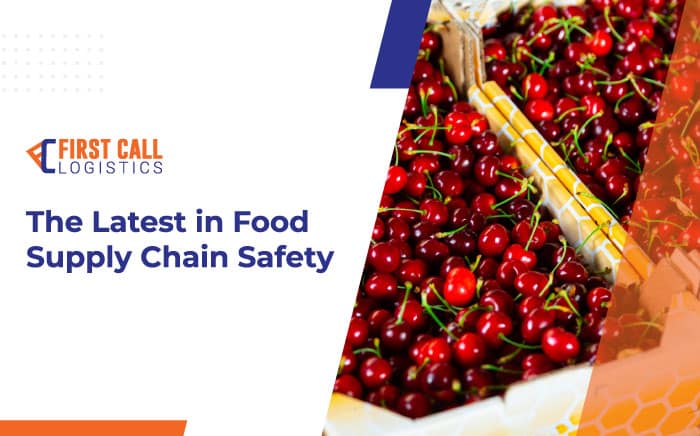The Latest in Food Supply Chain Safety

The global food supply chain is vast. It is complex, diverse, heavily regulated and essential for everyday consumers numbering in the billions. Perhaps most of all, it’s incredibly dynamic — it evolves continuously, capable of absorbing large-scale disasters with remarkable resilience while also demonstrating a sobering fragility.
It’s…a lot.
Successfully managing the logistics of food transport involves taking on a number of challenges all at once, in an effort to mitigate common risks and serve customers in the most efficient possible manner. Here are a few basics shippers need to know before transporting food across the globe:
Understanding Common Threats to Food Safety
Fires, floods and other aggressive acts of mother nature tend to grab headlines in regards to supply chain disruption, but natural disasters are far from the only cause of shipping damages and delays. Non-damage business interruptions such as service or utility outages, government-imposed closure orders, civil disturbances and cyberattacks can all cripple a food supply with little warning.
While logistics professionals will often mitigate these events through supply chain diversification, consistent evaluation of logistics processes and enlisting the services of a trusted 3PL, food and beverage shipments pose additional challenges:
- Food security fraud. Products with high prices are often targeted by counterfeiters, who swap quality products for cheap substitutes.
- Food spoilage due to weather delays. Food and beverage freight often require optimal temperature conditions; weather delays increase the risk of spoilage.
- Stock contamination and/or foodborne illnesses. Food can rot, deteriorate or become otherwise contaminated, resulting in spoiled products and massive recalls.
- Extra red tape. Regions producing major commodities like cocoa, coffee, soybeans and wheat are often susceptible to international customs delays and political instability.
8 Simple Steps for Safer Food Transport
Even as we collectively prepare for this year’s biggest trends in food and beverage shipping, the occasional disruption is still bound to strike. Here are a few things shippers can do to effectively mitigate damage to food shipments:
- Empower your employees to report issues. The men and women on the ground are your first line of defense against food safety threats. Well-trained employees will be the first to identify problems with food and beverage freight handling or breaches in typical transport protocol.
- Verify suppliers, distributors and carriers. Always confirm your partnering companies conduct thorough property health and safety audits, and make use of both WMS and TMS to track shipments in real time, including stops at any storage facilities, docks and fulfillment centers.
- Observe FSMA regulations. The Food Safety Modernization Act (FSMA) requires producers to track all movements of food products, from the supplier to the point of sale.
- Examine supplier labels. Receivers should immediately check new shipments for damaged packaging, special handling instructions and sanitary conditions.
- Check your trucks. Ensure every tractor and trailer is in good working order — particularly refrigerated trailers.
- Familiarize your drivers with safe practices. Every driver needs to be familiar with the industry’s best practices for keeping food fresh on the road.
- Maintain meticulous records. Keep detailed records of every action or precaution you and your employees take to ensure food sanitation and safety.
- Get insured. Non-damage business interruption insurance typically covers expenses associated with the disruption’s consequential losses, however specific terms and conditions of coverage vary depending on the policy and the nature of the business.
Preventing Foodborne Illness
Foodborne disease affects roughly 48 million people in the United States each year. The Food and Drug Administration (FDA) is working to tighten regulations from merely reactionary measures to preventative industry safeguards. The Food Safety Modernization Act is likewise shifting its focus to prevention (more on that here), instituting several new processes to encourage safety along the global food supply chain.
These regulations affect the following familiar areas:
- Refrigeration — ensure the proper temperature for all foods.
- Labeling — ensure every product is labeled correctly.
- Traceability — ensure there is visibility for every step of the supply chain process.
- Supplier verification — ensure suppliers are verified with the FDA.
- Sanitation on all modes of transportation — ensure all modes of transportation are sanitary to help prevent any contamination or foodborne illnesses.
Safer Food Shipping with First Call
First Call’s experience in perishable food transport dates back to our earliest beginnings as a produce shipper. Our team’s decades of work in both storing and shipping temperature-controlled goods has prepared us to take on virtually any food item you can throw at us (…don’t actually throw it at us). Industry-leading tech integration and a trusted nationwide carrier network also work to bring our partners peace of mind when moving sensitive freight across the country.
Contact us today and let us help freshen up your food supply chain!
Streamline Delivery with Flexible Storage Solutions
Speedy delivery is crucial to any growing business. First Call’s Warehousing & Distribution Services can help establish resilient supply chains, deliver products on time and achieve long-term business goals.
More Resources on Warehousing and Distribution Solutions:
Get the latest supply chain news and updates directly to your inbox.
